Bugs Bunny in Drag


Much has been made of the large number of times Bugs Bunny has appeared in women’s clothing in his
cartoons. All sorts of outrageous assumptions and slanderous accusations have been leveled at Bugs, with dark hints
made about his character. If anyone should be examined, it should be the Warner Brothers cartoonists, who were not
above appearing in drag themselves, as shown in a gag reel made by the cartoonists, an excerpt of which is seen in the
video of Chuck Amuck. Recent Warner Brothers cartoonists have also kept up this tradition.
In the following list of cartoons, Bugs appears in some form of ladies garb or does a female-like
turn:
- Hare-um Scare-um (Hardaway/Dalton, 1939)
Bugs dresses up as a female dog to spoof the hunting dog.
- Elmer’s Pet Rabbit (Jones, 1941)
Bugs dances with Fudd and addresses him saying, Katherine Hepburn-like, “You dance divinely, really you do.”
- The Heckling Hare (Avery, 1941)
The dog believing that he killed Bugs, lays flowers next to his home, and Bugs takes the dog’s flowers coquétteishly,
saying “For me? Oh, you darling!”
- The Wabbit Who Came to Supper (Freleng, 1942)
After shaving his face and underarms, and puff powdered, Bugs appears in womens’ lingerie and screams as Fudd opens
the door on him.
- Bugs Bunny Gets the Boid (Clampett, 1942)
Dances with Beaky Buzzard and asks “Why don’t we do this more often?” Also appears interrupted mid-shower by the bird,
and replies coyly “You naughty, naughty boy!”
- Super-Rabbit (Jones, 1943)
Brief appearance as Little Bo Peep owing to a costume mixup in a phone booth when changing into Super-Rabbit.
- A Corny Concerto (Clampett, 1943)
Appears as a ballerina, ultimately wrapping his brassiere around the heads of Porky and his hunting dog.
- What’s Cookin’ Doc? (Clampett, 1944)
Arises, Carmen Miranda-like, from a mountain of fruits and vegetables which have been hurled at him.
- Bugs Bunny Nips the Nips (Freleng, 1944)
Appears as a geisha who mallets a Sumo wrestler.
- Hare Ribbin’ (Clampett, 1944)
Appears as a blonde mermaid, driving the Mad Russian dog – well, mad.
- Stage Door Cartoon (Freleng, 1945)
One of the can-can dancers Fudd whistles at.
- Herr Meets Hare (Freleng, 1945)
Appears as a Wagnerian heroine dancing with Hermann Göering. Same gag used again in What’s Opera,
Doc? (Jones, 1957).
- Hare Conditioned (Jones, 1945)
Appears as a lady customer who charms the Gildersleeve-like floorwalker, laughing hysterically when Gildersleeve
tickles “her” mannequin’s foot.
- Hare Trigger (Freleng, 1945)
In an old western setting, Yosemite Sam gets embarassed when opening a train door compartment only to find Bugs
getting dressed.
- Hair-Raising Hare (Jones, 1946)
Bugs distracts the pursuance by Gossamer (a hairy, orange, sneaker-wearing monster) pretending to be a lamp, starts
dancing, and the lampshade drops from his head to his waist becoming a skirt. Then Bugs acts as a beauty parlor
stereotypical effeminate male manicurist. In a very feminine speech pattern, he states “I said to my girlfriend just
the other day, …” Same gag except as a hairdresser used in Water, Water, Every Hare
(Jones, 1952).
- Easter Yeggs (McKimson, 1947)
Bugs ends up floating in a raft through a log upon which Elmer jumps in, only to come out the other end of the log
(“Tunnel of Love”) with Elmer hugging Bugs and Bugs replying in a feminine voice, “I bet you say that to all the
women.”
- Mississippi Hare (Jones, 1948)
Appears as a dainty southern belle who is rescued by a big southern beau from the clutches of Colonel Shuffle. When
the beau discovers Bugs is a rabbit, he goes into a trance and walks off the boat, prompting Bugs to observe that he
almost had a happy ending.
- Haredevil Hare (Jones, 1948)
Bugs as coquétte again, romancing K-9, observes that “there’s a beautiful Earth out tonight.”
- Hare Splitter (Freleng, 1948)
Bugs impersonates his girlfriend Daisy Lou to abuse a rival, Casbah.
- Bowery Bugs (Davis, 1949)
Bugs uses many disguises in this one, one of which is female, in order to heckle Steve Brodie, to the extent that
Brodie jumps off the Brooklyn Bridge.
- Long-Haired Hare (Jones, 1949)
Bugs appears as a bobby-soxer, asking for the autograph of Giovanni Jones with a dynamite pen.
- Frigid Hare (Jones, 1949)
Bugs appears as an Eskimo woman to woo an Eskimo hunter away from catching a cute little penguin at the South Pole.
The infatuated hunter gives Bugs a gift – a fish, which Bugs wears as a woman’s hat briefly before clobbering the
hunter with it.
- Rabbit of Seville (Jones, 1949)
Elmer chases Bugs into an opera house, where they wind up on stage performing The Barber of Seville. Bugs
dresses up in a green dress, later dances with a wobbly Elmer, ending with Elmer dressed as a bride and Bugs the
groom.
- The Windblown Hare (McKimson, 1949)
Beginning with the wolf playing the role from The Three Little Pigs and changing to Little Red Riding
Hood, Bugs appears as Little Red Riding Hood singing The Rabbit in Red to the tune of The Lady in
Red.
- What’s Up Doc? (McKimson, 1950)
Bugs tells of his career in flashback, from piano-playing as a baby to stardom at Warner Brothers, which includes a
time when he appears as a ballerina.
- Hillbilly Hare (McKimson, 1950)
Appears as an Ozark cutie who wows the Martin brothers.
- Rabbit Fire (Jones, 1951)
Bugs appears as a huntress with Daffy as Gypsy, her hunting dog.
- Water, Water, Every Hare (Jones, 1952)
Bugs portrays himself as a beauty parlor stereotypical effeminate male hairdresser to Gossamer, during which he
strikes a pose in a very feminine manner. Same gag except as a manicurist used in Hair-Raising
Hare (Jones, 1946).
- Rabbit Seasoning (Jones, 1952)
Appears as a “stacked” Lana Turner-type, who bamboozles Fudd into shooting her a duck.
- Southern Fried Rabbit (Freleng, 1952)
Bugs crosses the Mason-Dixon line towards Alabama where the carrot crop is healthy, only to encounter Yosemite Sam as
a confederate soldier. Sam searches inside a southern plantation, while Bugs is dressed as a southern belle.
- Hare Trimmed (Freleng, 1953)
First as Granny, then eloping with Yosemite Sam as a bride. Bugs’ bridal gown gets caught on a nail, revealing his
tail. Upon seeing this, Sam goes nuts.
- Robot Rabbit (Freleng, 1953)
Bugs once again dances with Fudd and addresses him saying, Katherine Hepburn-like, “You dance divinely, really you
do.” Later, to distract a robot destroyer, Bugs appears as a robot cutie – in a potbellied stove, no less.
- Rabbit Rampage (Jones, 1955)
Bugs, who has definite ideas as to how he should be drawn, clashes with and irritates the cartoonist who creates him,
who proceeds to draw Bugs in all kinds of outrageous costumy appearance including two large hat scenes.
- Napoleon Bunny-part (Freleng, 1956)
Bugs dresses as Josephine in a pink french gown and bonnet to fool Napoleon.
- To Hare is Human (Jones, 1956)
Bugs dresses in a pink apron skirt with his ears tied in a bow during house cleaning chores, while Wile E. Coyote
consults his Univac computer as to how to capture Bugs.
- What’s Opera, Doc? (Jones, 1957)
In perhaps his most famous example of crossdressing, Bugs appears as Brünnhilde and sings the Maltese aria Return
My Love, (set to Wagner’s Pilgrim Theme from Tannhäuser) with Elmer Fudd.
- Bedevilled Rabbit (McKimson, 1957)
Bugs appears as a Tasmanian She-Devil to attract Taz.
- Now, Hare This (McKimson, 1958)
Using the stories Little Red Riding Hood and Goldilocks and the Three Bears with three “male”
characters (Bugs, Big Bad Wolf and his Nephew) could only result in all of them crossdressing. In the
beginning skit the Nephew appears as Little Red Riding Hood and Bugs takes over that role while the Big Bad
Wolf plays Grandma. The following skit has Bugs playing Goldilocks while the Big Bad Wolf doubles as Papa Bear and Mama
Bear.
- Hare-abian Nights (Harris, 1959)
Bugs finds himself having to entertain the Sultan as a story teller, and recalls a scene from Water, Water, Every Hare (Jones, 1952) where he portrays himself as a beauty parlor stereotypical
effeminate male hairdresser.
- Backwoods Bunny (McKimson, 1959)
While vacationing in the Ozarks, Bugs appears as a woman to distract a hillbilly buzzard from shooting him.
- The Unmentionables (Freleng, 1963)
Appears as a flapper who kicks Rocky while doing the Charleston.
- Bill of Hare (McKimson, 1962)
Bugs finds himself thrown in a cooking pot by Taz, only to pop out as a woman taking a bath.
- Dr. Devil and Mr. Hare (McKimson, 1964)
Bugs teases Taz as a nurse.
- Carrotblanca (Cahill/McNally, 1995)
In a theatrical short of the classic movie Casablanca with a Looney Tune twist, featuring beloved Bugs Bunny
as the carrot-chomping proprietor (Bogart) of a wacky distortion of Casablanca’s Cafe Americain, Bugs appears
as a blonde in a pink dress just before hitting Yosemite Sam with a pink purse containing an anvil.
- From Hare To Eternity (Jones/Clough, 1996)
A musical/theatrical short with the Swashbuckler Yosemite Sam digging for treasure and finding Bugs, who distracts Sam
by appearing as Buttercup, a mermaid.
- Looney Tunes: Back in Action (Dante, 2003)
A movie release, where the Warner Brothers VP Kate Houghton (Jenna Elfman) is discussing ideas for revamping
Bugs’ career:
- Kate: “We team you up with a hot female co-star.”
- Bugs: “Usually, I play the female love interest.”
- Kate: “About the crossdressing thing. In the past, funny. Today, disturbing.”
- Bugs: “Lady, if you don’t find a rabbit with lipstick amusing, you and I have nothing to say to
each other.”
And while at the Louvre in Paris, Bugs along with Daffy Duck dress as showgirls on stage to distract Elmer.
Bugs Bunny en Femme Gallery
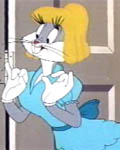
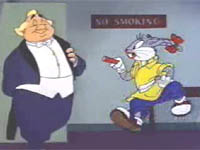
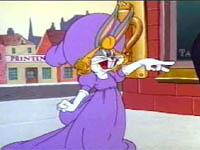

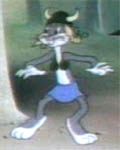
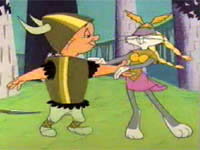
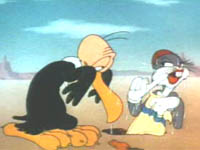
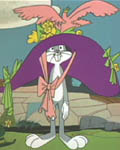
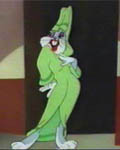
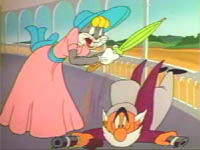
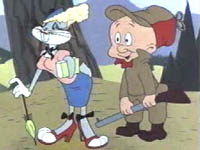
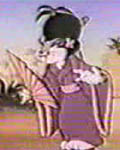
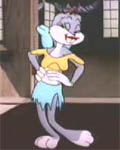


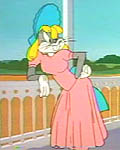


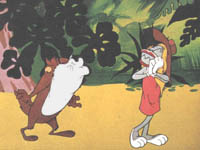
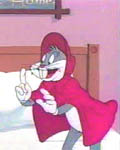
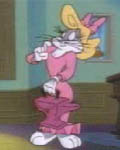

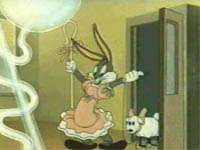
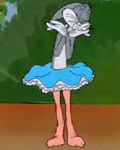
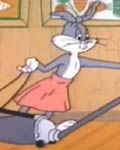
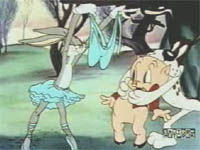
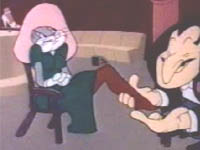
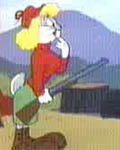
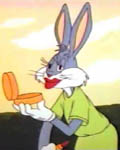
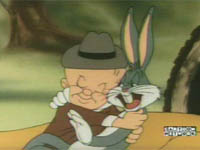
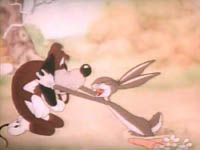



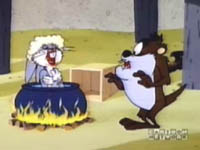
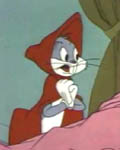
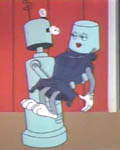

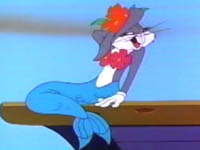
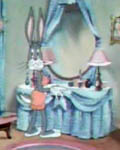
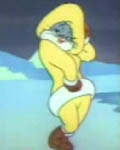
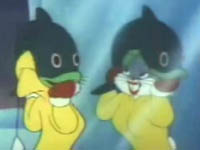
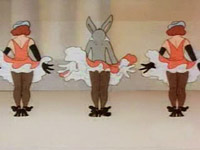
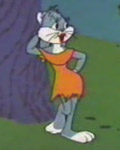

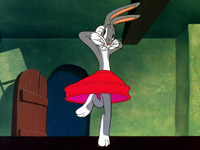
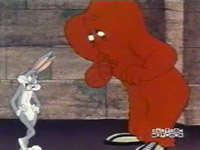
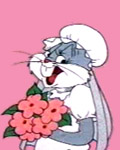
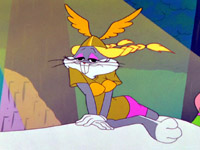
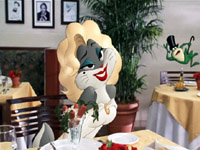

Bugs Bunny’s Crossdressing ‘Sisters’
Of course, other characters did their share of crossdressing as well. In The Wacky
Wabbit (Clampett, 1942) Bugs cuts Elmer’s outer clothing exposing Elmer’s corset, and after a wolf
whistle from Bugs, Elmer replies to the camera, “Don’t laugh… I bet plenty of you men wear one of these.” Bugs dresses
Elmer in a snappy green number, wig, and lipstick in The Big Snooze (Clampett,
1946), which certainly gets the attention of some Hollywood wolves. Elmer poses as a female duck in What Makes Daffy Duck? (Davis, 1948) and also ends up as the bride in Rabbit of Seville (Jones, 1949). In Bugs’ Bonnets (Jones, 1956),
where the characters take on the role of whatever hat falls upon them, Bugs helps Elmer (the lady) across the street,
ending with Elmer wearing a wedding hat asking Bugs in a top hat “Will you marry me?” to which Bugs replies “Certainly
my darling, sweetie. I’d be delighted to marry up with you.”
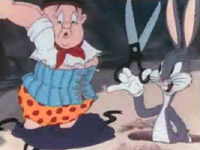

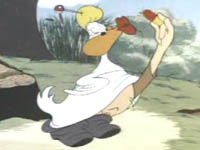
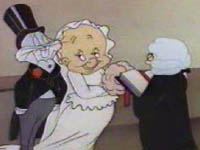
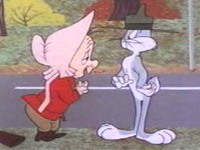
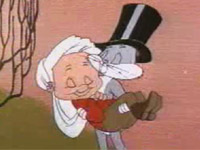
Daffy Duck does a striptease in The Wise Quacking Duck (Clampett,
1943), dresses up as Princess Gitchigoomie in The Daffy Duckeroo (McCabe,
1942), as a persistent agent to a talent scout (Porky) does a Carmen Miranda number in Yankee
Doodle Daffy (Clampett, 1943), appears as a Pochahontas-type in Boobs in the
Woods (McKimson, 1940) and does a can-can to Latin Quarter in Daffy Duck
Hunt (McKimson, 1949). Daffy also does a can-can and appears as a woman restaurant patron in Daffy’s Inn Trouble (McKimson, 1961). He also appears as a witch, after a superhero
costume change mistake in Stupor Duck (McKimson, 1956). And in the release Looney Tunes: Stranger than Fiction (Belfer, 2003), Episode 6 of the “Mysterious
Phenomena of the Unexplained” Daffy appears as a woman with Taz in the Shakespeare Play “The Taming of a
Screwball.”
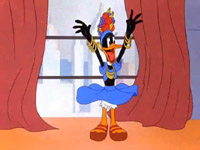
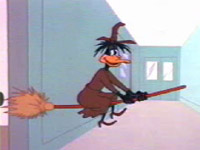
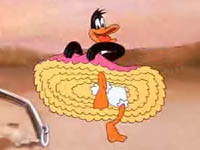
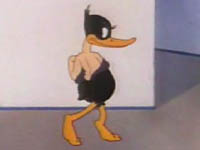
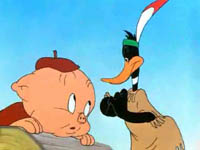
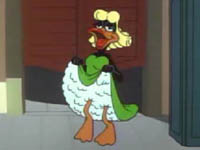

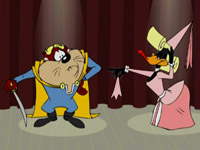
Wile E. Coyote dresses up as a female Road Runner in Ready, Set, Zoom!
(Jones, 1955), and along with the Road Runner, as a blonde hitch-hiker in Going! Going!
Gosh! (Jones, 1952), and as a schoolgirl in Fast and Furry-ous (Jones,
1949).

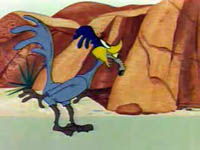
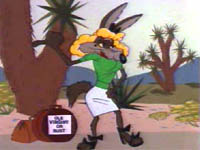
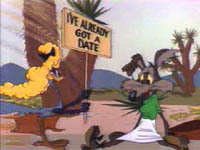
In A Bird in a Guilty Cage (Freleng, 1952) Sylvester Cat appears
in an after-hours department store. After woman mannequins crash down on him, he ends up wearing them, and while trying
to find Tweety Bird in a group of hats, he stops to try on different hats admiring himself in the mirror. While we’d
expect in the several Little Red Riding Hood cartoons the character playing the big bad wolf to dress as grandma, we
also find Sylvester appearing as a fairy godmother in an effort to catch the mouse playing the part of Little Red
Riding Hood in Little Red Rodent Hood (Freleng, 1952).

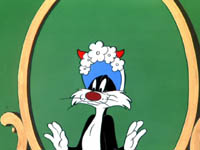
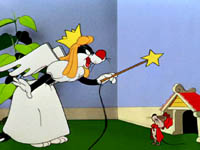
Other miscellaneous characters are not exempt from crossdressing either. In Awful
Orphan (Jones, 1949) we find a homeless obnoxious mutt wanting adoption sneaking in Porky Pig’s
high-rise apartment pretending to be a woman. And a similar adoption story is found in Porky’s
Pooch (Clampett, 1941) where the dog Rover does a Carmen Miranda impression. The Goofy Gophers end up
in a lumber yard in Lumber Jerks (Freleng, 1954), and when wood shavings from a
tree fly on the head of a gopher, it appears a woman’s wig as he dances and sings “There was a little girl who had a
little curl…” In Hollywood Steps Out (Tex Avery, 1941), Groucho Marx appears as a
woman. In Hollywood Daffy (1946) Daffy pretends to be a movie director and puts
lipstick on a studio cop he’s been avoiding.
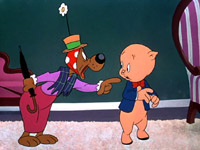
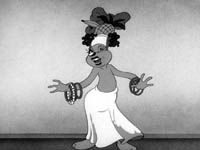
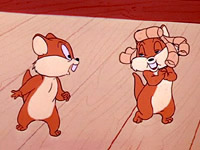
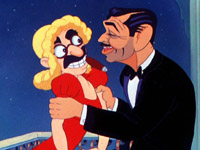
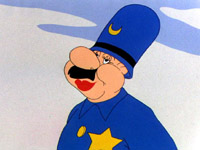
“Bugs Bunny in Drag” Forum
http://ca.groups.yahoo.com/group/bugsbunnyindrag/
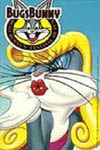
Want to join a forum (i.e., YahooGroup!) for Bugs Bunny in Drag
enthusiasts? Well, thanks to the efforts of Mary-Margret Callahan, now you can. The group is “dedicated to
the inspiration of many, the original drag queen of cartoon history… who was cool as a cucumber in all predicaments and
outwitted his opponents by dressing as a sexy diva, and looked great doing it… to the first bunny of drag…
Bugs.”
















































































